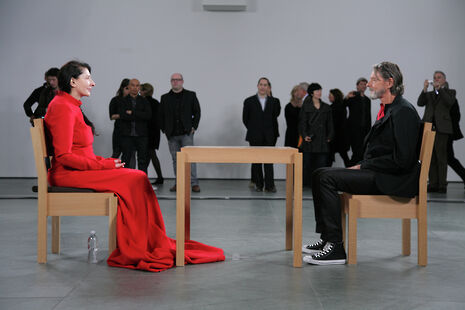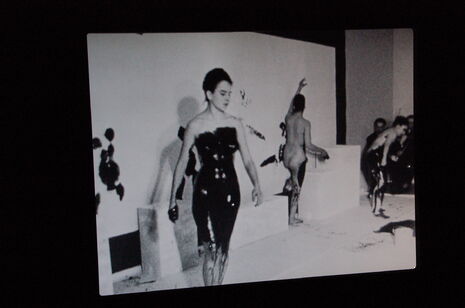‘Defining the exact boundaries between theatre and performance art can be complex’
Theatre, or performance art? Columnist, Zoé Barnes, looks into the nature of theatrical illusion

There are many forms of theatre, and the boundaries between various styles fluctuate over time and depending on who you ask. Anyone who has an appreciation of art and the more experimental forms of theatre may feel that sometimes, defining the exact boundaries between theatre and performance art can be complex.
Most arguments seem able to be justifiably countered. For example, performance art is presented within a fine art context, but so too can be theatre. Whether a scripted performance staged in an art gallery, or an installation work where an audience can move through the performance at their leisure, taking as much or as little time as they choose to experience it, theatre can be just as immersive.
My initial thoughts were as to whether ‘performance art’ was theatre heightened to pure creation, or an ephemeral form of art, subject to the caprices of the human body, but it is more complex than that.
A polarising opinion, and one which should be offered due deference, belongs to Marina Abramović, the grande dame of the performance art world. In 2010, prior to beginning a 700-hour-long performance at the Museum of Modern Art in New York, she was asked what the difference between performance art and theatre was, to which she replied, “To be a performance artist, you have to hate theatre. Theatre is fake… The knife is not real, the blood is not real, and the emotions are not real. Performance is just the opposite: the knife is real, the blood is real, and the emotions are real.”
“Performance art pushes the body to extremes and seeks not to fake emotion, but to use art as a way of releasing emotion”
Performance art pushes the body to extremes and seeks not to fake emotion, but to use art as a way of releasing emotion. This is an arguable difference between theatre and performance art. At the same time, this statement comes in the wake of a number of theatrical techniques of method acting that shy away from fake emotion, and demand emotionally sincere and expressive performance.
Actors train their body and mind to adapt to the psychology of characters, and the preparation that goes into these works of theatre are almost, in themselves, performance art, pushing the human body to the extremes of experience or empathy.
Is theatre without narrative, however loose, therefore performance art? Experimental theatre can be surreal and difficult to understand, but it does still tend to have a narrative unto an end and, even if the actors are playing themselves and improvising wildly, they are still character-based constructs.
Performance art is more insular and, rather than emulating or experiencing life as it is, seeks to create new boundary-pushing experiences. Vito Acconci, a performance artist who died earlier this year, was the originator of Seedbed, during which he would position himself in the confined space under a specially constructed ramp and masturbate, allowing the sound of the visitors walking above him to inspire him in his sexual fantasies.

While he may well have been forcing himself to focus on these fantasies, he wouldn’t invent them, but instead, give way to the extreme sway they could hold over him as a human being. This highlights the notion that performance is selfish and highly individualistic, even when performed as a group, where a performer with their own idea will delve into their own mental and physical construction, insensible to the reaction created. It isn’t repeated or constructed as theatre is, and it is not an emotional construction as such, but dependant upon the mental and physical extremes to which the performer is willing to go.
The paradox of this is that, though it is up to the viewer whether or not they respond to a performance art piece, the very nature of performance means that an audience should be present, because the work is done for the audience and, without an audience, there are certain worlds of performance art which cannot climb the summits without reaction to stimulation and cannot therefore have meaning.
Of course, it depends on the piece in question. A similar paradox exists in theatre which does not need to necessarily have an audience at all and may still reach its heights (take, for instance, theatre within a rehearsal context) without but, without the perceived integrity of performance art.
It is also noteworthy that theatre can end up borrowing from and being greatly influenced by performance art, which has developed from visual arts originally in a way that theatre, existing since time immemorial as a means of telling stories, has not.
“Theatre and performance art both expose the human body residing at the core of creative function and exaltation, but they seek to expose the body in different way”
Besides that, does the presence of a living body in a work of art necessarily make it a performance art? Take Yves Klein and his Anthropometries de l’Époque bleu, in which naked models are used as paintbrushes to make paintings and the body was an instrument, like a paintbrush. This has been decried by some as sexist, reducing women to tools, but that detracts from the expressive beauty inherent in the movement of the body.
On the one hand, the installations resulted in the creation of works of arts. On the other hand, the installations were performances and works of art in themselves. In this case, the latter also gives the models used autonomy and joint ownership of the works of art created. They must therefore be called artists and not merely models.
In videos of the pieces, Klein hardly gives any directions, and rather lets the artists follow a few given instructions and then make the work themselves – they do so in front of an audience whilst musicians play Monotone Symphony, a single note played for twenty minutes, followed by twenty minutes of silence. To not call the models ‘artists’ dehumanises them, and to avoid this dehumanisation, one must consider that the use of any human body in a work of art created for an audience must be performance art.
Theatre and performance art both expose the human body residing at the core of creative function and exaltation, but they seek to expose the body in different ways and to allow the body to explore its relation to life and experience in varying forms. Vocalisation, setting, narrative and authenticity all shape that which is created and give clues as to the intentional style and purpose of a work.
In the end, though, perhaps the very clearest way of being certain as to what you are supposed to be responding to is to see how the artist in question responds to it themselves, and respecting that they have the knowledge and autonomy to do so
 News / Cambridge academics stand out in King’s 2026 Honours List2 January 2026
News / Cambridge academics stand out in King’s 2026 Honours List2 January 2026 Interviews / You don’t need to peak at Cambridge, says Robin Harding31 December 2025
Interviews / You don’t need to peak at Cambridge, says Robin Harding31 December 2025 Comment / What happened to men at Cambridge?31 December 2025
Comment / What happened to men at Cambridge?31 December 2025 News / Varsity’s biggest stories of 202531 December 2025
News / Varsity’s biggest stories of 202531 December 2025 Features / “It’s a momentary expression of rage”: reforming democracy from Cambridge4 January 2026
Features / “It’s a momentary expression of rage”: reforming democracy from Cambridge4 January 2026









